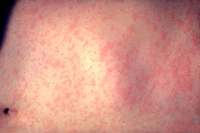
Measles are an extremely contagious virus infection of the respiratory system caused by the Morbillivirus genus. Measles are spread through respiration (contact with fluids from an infected person's nose and mouth, either directly or through aerosol transmission). 90% of people without immunity sharing living space with an infected person will catch it. An asymptomatic incubation period occurs nine to twelve days from initial exposure and infection lasts from two to four days before until two to five days after the onset of the rash (i.e. four to nine days infectivity in total).
An alternative name for measles in English-speaking countries is rubeola, which is sometimes confused with rubella (German measles). The diseases are unrelated.
The classical symptoms of measles include four-day fevers and the three Cs—cough, coryza (head cold) and conjunctivitis (red eyes). The fever may reach up to 40 °C (104 °F). Koplik's spots seen inside the mouth are diagnostic for measles, but are not often seen, even in real cases of measles because they may disappear within a day of appearing.
The characteristic measles rash is classically described as a generalized, maculopapular, erythematous rash that begins several days after the fever starts. It starts on the head before spreading to cover most of the body, often causing itching. The rash is said to "stain", changing color from red to dark brown before disappearing. The measles rash appears two to four days after initial symptoms and lasts up to eight days.
Complications with measles are relatively common, particularly in adults that catch it. Complications can range from relatively mild diarrhea to pneumonia, Otitis media (inner ear issues), acute encephalitis (swelling of the brain), and corneal (eye) ulceration which leads to corneal scarring.
NOTE: Dr. DeHaan does not believe the MMR vaccine is a healthy choice for healthy children. More >>
